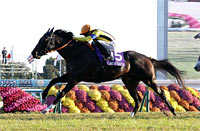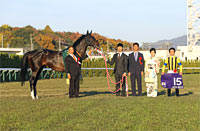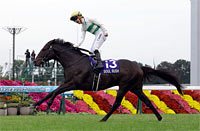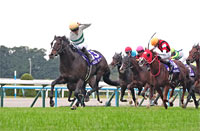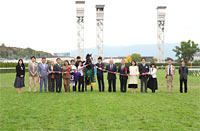Mile Championship (G1) - Data Analysis
Autumn mile champion decider to be held at Kyoto Racecourse for first time in four years
This year, the Mile Championship will return to Kyoto Racecourse for the first time in four years, after having been held at Hanshin Racecourse for three consecutive years. Of the 30 Top 3 finishers over the last 10 years, 23 were backed as 5th favorite or higher, while runners backed as 10th favorite or lower produced zero Top 3 finishers. Let’s now analyze some features shared by successful runners in this race based on results over the last 10 years.
Runners that have finished 6th or lower in previous race tend to struggle
Of the 30 Top 3 finishers over the last 10 years, 29 had finished in the Top 5 of their previous race. The only Top 3 finisher that had finished 6th or lower in his previous race was 2014 winner Danon Shark. From 2015 onward, none of the 52 runners that had finished 6th or lower in their previous race secured a place in the Top 3. This year, therefore, it would again seem prudent to sharply discount runners that have been beaten to 6th or lower in their previous race. [Table 1]
[Table 1] Performance by finish in previous race (last 10 years)
| Finish in previous race |
Performance
[1st-2nd-3rd-4th or lower] |
Win ratio |
Top 2 ratio |
Top 3 ratio |
| 1st |
3-2-3-23 |
9.7% |
16.1% |
25.8% |
| 2nd |
2-4-1-16 |
8.7% |
26.1% |
30.4% |
| 3rd |
3-3-2-14 |
13.6% |
27.3% |
36.4% |
| 4th |
0-0-3-14 |
0% |
0% |
17.6% |
| 5th |
1-1-1-14 |
5.9% |
11.8% |
17.6% |
| 6th-9th |
1-0-0-25 |
3.8% |
3.8% |
3.8% |
| 10th or lower |
0-0-0-38 |
0% |
0% |
0% |
Check distance of previous race
Looking at performances by runners over the last 10 years in terms of the distance of their previous race, we find that although the number of runners appearing in the race varies by group, runners coming from a 2,000m+ race achieved the highest Top 3 ratio of 35.3%. As evident from a comparison with runners coming from a race with a distance of 1,400m or less (performance of [2-3-2-40], Top 3 ratio of 14.9%), 1,800m+ (performance of [4-3-6-41], Top 3 ratio of 24.1%), or 1,600m (performance of [4-4-2-63], Top 3 ratio of 13.7%), runners coming from races with a longer distance than the Mile Championship have the edge in Top 3 finishes and the Top 3 ratio. Our primary focus should therefore be on runners coming from an 1,800m+ turf race. [Table 2]
[Table 2] Performance by distance of previous race (last 10 years)
| Distance of previous race |
Performance
[1st-2nd-3rd-4th or lower] |
Win ratio |
Top 2 ratio |
Top 3 ratio |
| 1,200m |
2-0-0-7 |
22.2% |
22.2% |
22.2% |
| 1,400m |
0-3-2-33 |
0% |
7.9% |
13.2% |
| 1,600m |
4-4-2-63 |
5.5% |
11.0% |
13.7% |
| 1,800m |
2-2-3-30 |
5.4% |
10.8% |
18.9% |
| 2,000m+ |
2-1-3-11 |
11.8% |
17.6% |
35.3% |
Runners coming from same-year Yasuda Kinen are strong performers
The Yasuda Kinen is held in June as the spring mile champion decider. Runners that had contested the same-year Yasuda Kinen delivered performance of [6-10-4-51] (Top 3 ratio of 28.2%), and made up 20 of the 30 Top 3 finishers. Looking at performances by runners in terms of finish in the Yasuda Kinen, we observe that runners with a stronger finish generally achieved higher success ratios. Conversely, runners that had not entered the same-year Yasuda Kinen produced four winners, but achieved a Top 3 ratio of only 9.7%. When comparing recent race records, we should focus on runners that have contested the same-year Yasuda Kinen. [Table 3]
[Table 3] Performance by finish in same-year Yasuda Kinen (last 10 years)
| Finish |
Performance
[1st-2nd-3rd-4th or lower] |
Win ratio |
Top 2 ratio |
Top 3 ratio |
| 1st |
3-0-0-2 |
60.0% |
60.0% |
60.0% |
| 2nd |
1-0-0-4 |
20.0% |
20.0% |
20.0% |
| 3rd |
0-2-1-3 |
0% |
33.3% |
50.0% |
| 4th |
2-1-0-4 |
28.6% |
42.9% |
42.9% |
| 5th |
0-2-0-4 |
0% |
33.3% |
33.3% |
| 6th-9th |
0-4-1-13 |
0% |
22.2% |
27.8% |
| 10th or lower |
0-1-2-21 |
0% |
4.2% |
12.5% |
| No entry |
4-0-6-93 |
3.9% |
3.9% |
9.7% |
Check favoritism in same-year JRA G1 turf race
All 20 Top 2 finishers over the last 10 years had been backed as 9th favorite or higher in a same-year JRA G1 turf race. Within this group, we should especially not overlook runners that had been backed as race favorite or 2nd favorite as they both achieved a Top 3 ratio of 50.0%. Meanwhile, the 23 runners that had been backed as 10th favorite or lower and the 47 runners that had not entered a same-year JRA G1 turf race struggled, producing only one and two third-place finishers, respectively. [Table 4]
[Table 4] Performance by highest favoritism in same-year JRA G1 turf race (last 10 years)
| Highest favoritism |
Performance
[1st-2nd-3rd-4th or lower] |
Win ratio |
Top 2 ratio |
Top 3 ratio |
| 1st favorite |
4-0-1-5 |
40.0% |
40.0% |
50.0% |
| 2nd favorite |
2-6-1-9 |
11.1% |
44.4% |
50.0% |
| 3rd favorite |
1-0-1-10 |
8.3% |
8.3% |
16.7% |
| 4th favorite |
2-1-2-12 |
11.8% |
17.6% |
29.4% |
| 5th favorite |
0-0-0-7 |
0% |
0% |
0% |
| 6th-9th favorite |
1-3-2-34 |
2.5% |
10.0% |
15.0% |
| 10th favorite or lower |
0-0-1-22 |
0% |
0% |
4.3% |
| No entry |
0-0-2-45 |
0% |
0% |
4.3% |
Seek out the winner!
Runners that won a same-year graded race backed as race favorite have secured eight consecutive victories
The eight winners since 2015 had all won a same-year graded race backed as race favorite. If any of this year’s runners have such experience, they should be included among the leading contenders to win. [Table 5]
[Table 5] Same-year graded races in which winners secured victory backed as race favorite (last eight years)
| Year |
Winner |
Same-year graded races in which winners secured
victory backed as race favorite |
| 2015 |
Maurice |
Lord Derby Challenge Trophy, Yasuda Kinen |
| 2016 |
Mikki Isle |
Hankyu Hai |
| 2017 |
Persian Knight |
Arlington Cup |
| 2018 |
Stelvio |
Spring Stakes |
| 2019 |
Indy Champ |
Tokyo Shimbun Hai |
| 2020 |
Gran Alegria |
Sprinters Stakes |
| 2021 |
Gran Alegria |
Victoria Mile |
| 2022 |
Serifos |
Fuji Stakes |
(Michio Kawano)
|














